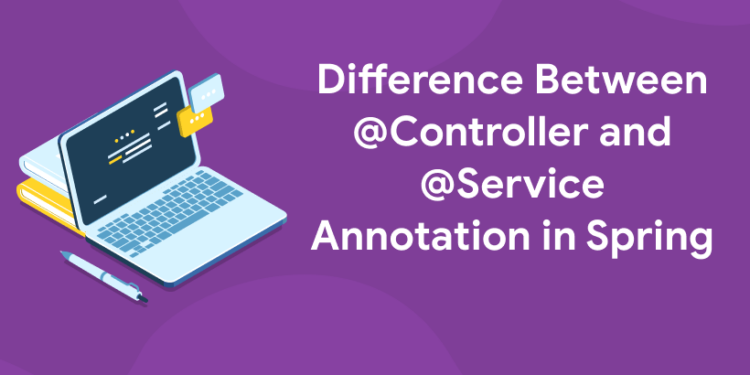Table of Contents
Spring provides two annotations, @Controller and @Service to annotate classes in the application so that Spring can create beans from those classes by autowiring method arguments and mapping method return values to bean properties respectively. But what’s the difference between @Controller and @Service annotation? What’s the difference between Autowire by Name and Autowire by Type? Spring framework comes with lot of annotations like @Repository, @Service, @Controller, @Component, etc that helps developers to achieve modularity in their applications. When developing a web application, you will come across the situation where you need to choose between @Controller and @Service annotations in Spring framework. The question arises as to what are the differences between these two annotations? Are they identical and when should one be used over the other? This article aims to help you understand their subtle differences and provide answers to such questions. Read on to know more!
Unlock Your Coding Potential with Our Programming Courses – Enroll Today
What Is the Purpose of Controller?
A Controller provides support for handling user requests. In a typical MVC structure, it is associated with a RequestMappingHandlerMapping class which maps URLs to specific controller methods. In other words, Controllers are used to mapping requests from users (via HTTP requests) to an application’s business logic. Controllers receive these requests, retrieve data from various sources using repositories, and prepare responses for users by writing them back to client browsers using ModelAndView objects. The following code snippet shows how to define a Controller: (@Controller(/user) public class UserController { @RequestMapping(value=/list, method=RequestMethod.GET) public String list() { return list; } } ) It should be noted that controllers are often placed inside packages, where they can be organized and namespaced appropriately.
What Are The Constraints?
One of the key considerations is that you cannot use both methods together in your same bean. In other words, you can only have one or another. The Controller design pattern is more suited to handling requests from clients, while Service design pattern is more suited to providing support for your business logic. Controller services are recommended for Java based RESTful Web Services, while Service services are recommended for Enterprise JavaBeans (EJB). This means that a controller service will handle request/response messages whereas a service service will be used to invoke operations on EJBs. This also means that a controller will provide JSON responses, while a service will return XML responses.
Learn Coding in your Language! Enroll Here!
When Should We Use Service?
If you have a lot of services, they should be used because they offer better abstraction than controllers. However, some may say that controllers are easier to read, so it’s a matter of preference. And as always with these things, use what you’re comfortable with because at some point your client will have to know about all of them anyway. The main difference is that controllers handle view logic (Servlet), and services handle business logic (business tier). Therefore, you would use service if your code was too complex for controller to handle or it wasn’t related to presentation layer. Another reason could be if your controller would end up doing too much work related to data manipulation because there are other models for that kind of work on presentation tier – DAO for example. This is especially true when you want to separate UI from application logic. In such case, service is best option since it allows you to focus on real work instead of just forwarding requests from one controller to another. There are two ways how we can define our custom annotation: XML and Java code.
Who Is Responsible For Working with Business Logic Layer?
When designing an application, it is important to recognize that there are two primary ways in which a developer can approach handling business logic: You can either handle all of your business logic by writing code directly into service classes. This is known as implementing a service class approach. However, it should be noted that because there is no clear separation of concerns or clear layering when it comes to services, creating loosely coupled applications becomes very difficult when they are built with service classes. When you implement a service class layer in your application, its entirely possible that your application’s controller layer will have no knowledge of what services exist for you to use; therefore its impossible for controllers to be able to work with services without going through some sort of injection mechanism provided by developers who created those services. In order to solve these problems, developers often turn to using annotated controllers instead of annotated services. When using annotated controllers, your business logic is moved out of your service layer and placed into separate controller classes that are responsible for working with models and persisting data. This type of design allows developers to create loosely coupled applications while still being able to keep their business logic separated from their view objects within their model layer. As a result, if you want one part of your application (such as a controller) to work with another part (such as a service), you simply inject an instance of the service into your controller and then call methods on it just like any other object within Java code!
When to Choose Both?
What if your service method needs access to a @RequestMapping annotated controller’s parameters? In other words, what if you want to invoke a traditional controller that has nothing to do with services (i.e., it has no related DAO layer) but still use it inside of your service code? If you find yourself in that situation, then be sure to inject your service bean into an annotation-based controller via an @Autowired dependency. That will give you access to all request parameters within any service methods that use those injected beans. However, there is another way. You can use both annotations on one class: @Controller and @Service . This approach lets you take advantage of both styles of controllers while avoiding unnecessary duplication. It also allows you to inject only your service classes into annotated controllers so that they can make use of them directly without needing to go through an intermediate step first.
Unlock Your Coding Potential with Our Programming Courses – Enroll Today
What If I Want To Use Only One or the Other?
Great question! If you want to use only one or want to know when it’s appropriate to use one over another, refer to our tutorials on how to create a controller class and service class. For example, if you’re starting with JSPs or servlets for your views, you’ll likely be creating a controller class (which extends from Controller). However, if you’re building Java EE web services based on JSPs or servlets, you may be implementing them as service classes (which extend from Service). Or maybe even both? You could easily have controllers that implement your business logic while having services that handle persistence. That’s just an example of course—you can do whatever makes sense for your application. In Spring, we often use @Controller or @Service annotation to define the application’s class that handles requests and processes data. But what is the difference between the two? This article will discuss their similarities and differences and provide an understanding of when to use one over the other. We’ll also give examples of both annotations in action so you can see them in action in your own codebase. Let’s dive right in!
Service and Controller are both programming constructs in the world of Java web development, but they serve different purposes. Controllers tend to be more visible to the outside world, while services tend to be more internal, so it’s important to understand the distinction between the two. This article will go over the difference between Spring Controller and Service annotations so you can tell them apart in your own projects going forward. The Spring Framework includes many annotation-based configuration elements to make your job as a developer easier, including @Autowired and @Service. What’s the difference between the two? Which should you use when? This article examines the two annotations and how they fit into your application design with simple examples and an annotated class diagram at the end of this article.
Spring Boot
One of Spring Boot’s most useful features is that it makes a developer’s life easier by removing a lot of complexity from what would otherwise be required to run a basic application. It does this via starter POMs for popular build tools and platforms such as Maven, Gradle, SBT and GVM, along with providing auto-configuration for things like logging and metrics. All you need to do is create some Java classes—with annotations if you want—and let Spring Boot handle all other configuration requirements. The Boot portion of Spring Boot refers to its goal of getting your app up and running as quickly as possible by taking care of infrastructure issues for you at runtime. As a developer, you’ll spend more time coding new features and less time setting up servers. This means you can get to market faster and focus on solving real business problems instead of wasting time on boilerplate code. In addition, because Spring Boot provides a convention over configuration approach, there are very few decisions left up to developers when creating an application. You just need to decide which components (or features) you want in your application and let Spring Boot worry about how they’re wired together behind the scenes. This reduces cognitive load and allows developers to focus on writing code instead of dealing with configuration files or XML.
Are you aspiring for a booming career in IT? If YES, then dive in |
||
Full Stack Developer Course |
Python Programming Course |
Data Science and Machine Learning Course |
Method Names
Services annotated with @Service must define a public default void no-args method called execute. Controllers annotated with @Controller do not need to define execute or any other methods, and it is permissible for them to directly call services and other controllers. For example, your service could call a controller using getModel().doSomething().getView().render(), although that violates MVC principles because it’s mixing concerns, but such things are common in simple applications. Generally speaking, avoid calling one controller from another unless you’re doing something sophisticated or need to mock out certain features during testing. The important thing is to make sure all calls within an application are between controllers and their views. Otherwise, controllers may wind up violating single responsibility (SRP) by invoking functionality they don’t own. In theory, they should only invoke their own business logic and never anything outside of themselves. It may be convenient at times to simply pass along information between layers, but remember that your goal is clean code that has been tested independently so you can be confident about changes over time without breaking other features in unexpected ways (which happens more often than you might think). If there’s an easy way to keep things separate at runtime—such as keeping service objects isolated from controllers via interfaces—you should consider taking advantage of it.
Spring MVC
Spring’s MVC framework is extremely flexible, but it requires a great deal of work on your part to figure out how it works and exactly how it can be implemented in your application. This may feel like extra work at first—as if you could have just done things by hand—but remember that setting up an entire MVC framework yourself would require quite a bit of coding knowledge and time that could otherwise be spent working on other parts of your app. Spring is not limited to MVC frameworks, however; it’s also capable of implementing Aspect-Oriented Programming (AOP) to create some pretty slick code flow for your app. For example, you might use AOP to set up rules about what happens when a user presses a button or types something into an input field. By using AOP instead of writing all of these rules from scratch, you’ll save yourself tons of time and effort. It’s worth noting that AOP is more advanced than MVC and will take more time to learn. If you want to use Spring for basic web apps without any special features or requirements, stick with MVC as opposed to AOP until you need it later on down the road.
Reasons Why To Use a Controller Instead of a Service
Controllers in Spring are easy to write and use, whether you’re just getting started with web development or writing a complex application that needs to scale as demand increases. That’s because they serve a single purpose (routing), are designed to be lightweight, and can be reused easily if you build more than one web application using Spring Boot. If your service doesn’t require any special logic – meaning it simply exposes methods that perform operations on data – then a controller is definitely better suited for your needs. For example, say you need to build an eCommerce website where users can search for products from your inventory and then purchase them online. In that case, you might want to create a ProductController class that would contain all of your product-related business logic. The product controller would take requests from users and handle things like storing information about which products were added to their shopping cart and processing payments when orders were placed. In short, controllers provide much of what services do but with less overhead since they don’t have any configuration requirements outside of setting up a @Controller annotation. They also have fewer responsibilities since they’re not responsible for managing data persistence or providing other services like authentication/authorization support.
Learn Coding in your Language! Enroll Here!
Best Practices When Choosing Which to Use
@Controller and @Service can both be used to provide services or objects that are going to be injectable into other parts of your application. If you use one over another, it is because you have an idea of how they will behave in different situations (of course, they both ultimately become components that you inject elsewhere). There are some instances where one will work better than another; let’s look at what those are so that you can decide which is better for your project . The main difference between a controller and a service is that a controller should be stateless while a service should not. This means that if you need to store data, whether it’s just on initialization or throughout its life cycle, then it needs to go in a service instead of a controller. A controller will also only receive requests from clients while a service can send out responses as well as receive them. So if you want something with two-way communication then choose a service instead of a controller. If you are interested to learn new coding skills, the Entri app will help you to acquire them very easily. Entri app is following a structural study plan so that the students can learn very easily. If you don’t have a coding background, it won’t be any problem. You can download the Entri app from the google play store and enroll in your favorite course.
| Our Other Courses | ||
| MEP Course | Quantity Surveying Course | Montessori Teachers Training Course |
| Performance Marketing Course | Practical Accounting Course | Yoga Teachers Training Course |










